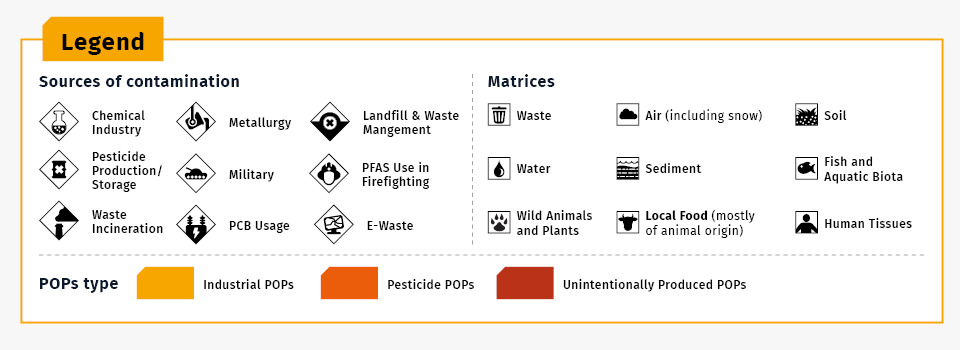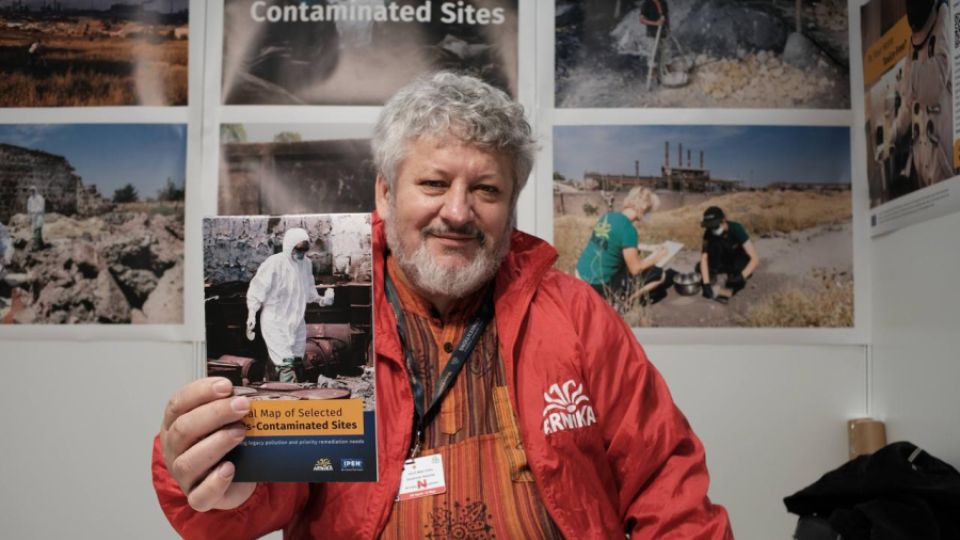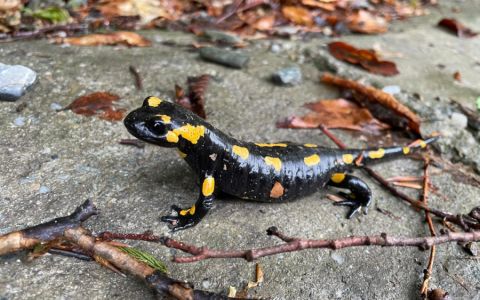The Stockholm Convention contaminated sites guidelines should advance steps toward a healthier planet by identifying POPs1 contaminated sites, minimizing exposure risks, and using non-combustion and other alternative technologies for safer waste disposal and site clean-up.
Geneva, April 28 - This week, the Stockholm Convention will address sites contaminated by persistent organic pollutants (POPs) and the need for a global guidance document that provides countries with information on how to map, manage, and remediate these polluted locations.2 In anticipation of the discussions, Arnika and IPEN (the International Pollutants Elimination Network) are releasing a world map that shows the breadth of the problem with an overview of more than 70 contaminated sites, including industrial areas polluted by the use, production of pesticides, PFAS, and other highly toxic POPs, and by sites polluted by POPs contained in or produced by plastic and other wastes that can create POPs when burned.
Jindrich Petrlik, creator of the map and Arnika Toxics and Waste Programme Director said, “This new map highlights the ongoing global problem from POPs chemicals that are among the most hazardous compounds ever developed. Even though some of these chemicals are no longer produced, POPs leave a legacy of contaminated sites that must be cleaned up. For example, our studies for more than two decades show long-term food chain effects from contaminated sites. If these locations remain unremediated, we will face ongoing risks to our health and the healthy environments we need to live.”
A POPs-contaminated site is a location where POPs are present at concentrations above natural background levels, posing or potentially posing a risk to human health and the environment. Most national frameworks classify a site as contaminated if pollution significantly harms people, ecosystems, water sources, or other receptors. The contamination may result from industrial activities, pesticide use, waste disposal, or other human actions leading to the accumulation of hazardous substances in soil, water, or air.
The map highlights just a few of the tens of thousands of POP-contaminated sites globally, which remain major sources of pollution. It is not meant to be a comprehensive review but aims to show how sites contaminated with POPs can take many forms: they may be old, abandoned chemical plants, obsolete pesticide storage sites, small medical waste incinerators, disposal facilities tainted with PCBs from paint, PFAS contamination, and many types of industrial locations.

Among the POPs chemicals noted in the locations described on the map are dioxins, PCBs, pesticides, toxic plastic chemicals (such as chlorinated paraffins), and others. Descriptions of some of the sites noted in the map include:
- In Latin America, at an electronics factory producing PCB-containing capacitors in Moreles, Mexico, high levels of PCBs were found in soils and in blood testing of children living nearby.
- In Asia, the Bien Ho Airbase is considered the most contaminated site in Vietnam, following its use as a US Air Force Agent Orange storage facility from 1962 to 1971. It remains heavily contaminated by dioxin with additional contamination from waste burning, pesticide use, and industrial activities. High levels of dioxins have been found in blood testing of local residents and in local foods including duck, chicken, chicken eggs, and beef. In 2019, USAID began a $183 million cleanup project but extreme budget cuts to the agency by the current US administration have put that project in jeopardy.
- In Africa, at a scrapyard in Accra, Ghana, high levels of PCBs, dioxins, toxic plastic chemicals and other chemicals from e-waste disposal, including open burning of plastic and other wastes, resulted in high levels of POPs contamination of soils and local food, with free-range chicken eggs from the area showing the highest-ever recorded levels of certain dioxins.
- In North America, chemical and oil industry dumping of dioxins in Lake Charles, Louisiana led to high levels of POPs found in blood testing of local residents and in free-range chicken eggs from the area.
- In Europe, a PFAS production site of the US company 3M resulted in high levels of POPs pollution of air, ground water, and local farms, with local eggs and vegetables considered unsafe to consume. Blood tests of area residents revealed dangerously high PFAS levels, with PFAS found in the blood of all people screened, and half of those screened showing high levels of four PFAS.
For the Stockholm Convention, IPEN and Arnika support the current guidance document that focuses on cleaning up POPs contaminated sites with techniques and technologies that do not generate more POPs and outlines examples of policy, legal, and financial frameworks that are important for a holistic approach to site management.
"It is important to support the elimination of these environmental burdens through technologies that do not generate new POPs such as dioxins. These will be discussed as an alternative to incinerators in a panel discussion organised by Arnika at the end of the meeting in Geneva, entitled 'Waste incineration and the triple planetary crisis'", says Nikola Jelínek, an expert on toxic substances and waste from Arnika, who took part in creating the map and is attending the meeting in Geneva in person.
For more details and information sources, please see an extended version of the map publication here, or a comprehensive version on Researchgate here.
Notes
[1] - POPs – persistent organic pollutants – are hazardous chemicals with distinctive and dangerous properties. They persist in the environment for a long time, can travel long distances through air or sea, and are ‘bioaccumulative’. This means they build up in living organisms, mainly in fatty tissue, with concentrations increasing up the food chain – peaking in top predators such as humans and polar bears. POPs are highly toxic, and levels found in some people and animals exceed those known to cause health and biological effects. Many act as endocrine disruptors (interfering with hormones), while others are carcinogenic, mutagenic (affecting DNA), or teratogenic (causing birth defects).
Some POPs are pesticides, others are industrial chemicals, and some are unintentionally produced during chemical or combustion processes. In all cases, they degrade very slowly and remain in the environment long after pollution sources cease. Because their use and production inevitably lead to environmental release, POPs pose serious, unavoidable risks to human health and ecosystems. It is therefore essential to ban or at least severely restrict their use and eliminate legacy stockpiles and residues. Identification of POPs contaminated sites is important to assess exposure risks but also to contribute to inventories of contaminated sites. Once developed, inventories can be converted to interactive maps and published online contributing to public right to know about POP risks in their region.
Safer alternatives are widely available and significantly reduce risks to people and wildlife. There are also better options for technologies and practices, such as waste incineration, that unintentionally generate POPs.
[2] - The Stockholm Convention is a global, legally binding treaty that entered into force on 17 May 2004 and, as of 1 January 2025, includes 186 Parties. It aims to eliminate major POPs, including pesticides, industrial chemicals, and unintentionally produced substances such as polychlorinated dibenzodioxins and dibenzofurans (known as 'dioxins').
Unlike earlier treaties focused only on air emissions (e.g. the Long-Range Transboundary Air Pollution Convention) or waste transport (Basel Convention), the Stockholm Convention addresses all major pathways by which POPs contaminate the environment, food chains, and human health. The map published highlights POP-contaminated sites, which are increasingly important as unremediated locations remain major sources of pollution. Although efforts were made to gather the most current information, the status of the sites presented on the map may have changed, and some of them may have already been remediated.
Article 6 of the Convention states: 'In order to ensure that stockpiles consisting of or containing chemicals listed' under the Convention 'are managed in a manner protective of human health and the environment, each Party shall: 'among other actions,'(e) Endeavour to develop appropriate strategies for identifying sites contaminated by chemicals listed in Annex A, B or C; if remediation of those sites is undertaken, it shall be performed in an environmentally sound manner'.







